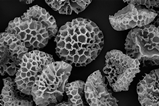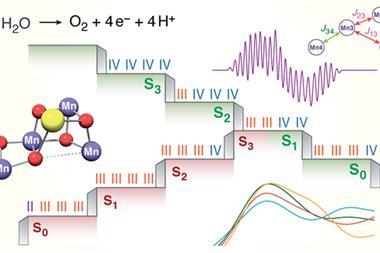Excitation energy transfer enhancements thought to compensate for decrease in charge transfer efficiency of going from monomers to dimers
Ancient photosynthetic reaction centres for converting light energy into chemical energy were monomeric. Modern photosynthetic reaction centres, however, are all dimeric. Now, scientists in Australia have outlined six possible explanations for this evolutionary switch and have concluded that the most plausible reason is that dimeric structures improved the reaction centre’s exciton- and charge-transfer capabilities.
Photosynthetic reaction centres are protein–pigment complexes that convert solar energy from sunlight into chemical energy through a process called charge separation. They exist as dimers, meaning they have two monomer subunits that work together. Two chlorophyll molecules known as the special pair, which act as an exciton acceptor and charge donor, join the two monomers.

Billions of years ago, the ancestors of these complexes existed as single units but no one has come up with a definitive reason for this change. ‘All photosynthetic reaction centres are dimeric in architecture, both at the protein level and at the cofactor level, where a closely coupled pigment dimer is at the heart of the complex,’ explains Robert Blankenship, who studies how photosynthesis has evolved at Washington University in St Louis, US. ‘The evolutionary and functional reasons for this dimeric architecture have long been discussed and have proved elusive to understand.’
Now, Natasha Taylor and Ivan Kassal, from the University of Queensland and the University of Sydney, respectively, have tackled the long-running question: why are photosynthetic reaction centres dimeric? ‘The structure of reaction centres was first solved in the 1980s, an achievement recognised with a Nobel prize in 1988, and we have learned a lot about how they work since then,’ explains Kassal. ‘But, the purpose of the dimerism, and of the strong coupling within the special pair, has been an important question since the beginning.’
They propose six evolutionary explanations for reaction centre dimerisation:
| Explanation 1 | Dimerisation occurred randomly. This explanation is improbable, as these sort of changes are very unlikely to survive in large organism populations. |
| Explanation 2 | Dimerisation served a structural purpose only. However, this explanation does not explain the strong special pair coupling that is important for the reaction centre’s functionality. |
| Explanation 3 | Dimerisation meant that the reaction centre could have two quinones, molecules that aid in the transfer of electrons in the reaction centre. However, transfer between quinones is an evolutionary recent phenomenon and does not explain why the ancestral reaction centre needed to become a dimer. |
| Explanation 4 | Dimerisation allowed the organism to absorb longer wavelengths of light within the special pair, meaning it could survive in environments where other organisms were harvesting shorter wavelengths of light to survive. This, however, does not explain why the monomeric reaction centres became extinct, as not a lot of photosynthetic organisms require longer wavelengths of light to survive. Therefore, there would be no pressure for the organism to evolve its reaction centre to have a dimer structure, in this case. |
| Explanation 5 | Dimerisation led to a heightened redox potential in the coupled special pair, which improved electron transfer. However, the ancestral reaction centre was not oxygenic, and did not need a high redox potential. Therefore, there was less of a reason for the reaction centre to become a dimer, in this case. |
| Explanation 6 | Dimerisation improved one of the reaction centre’s main functions, either as an exciton acceptor or as a charge separator. This enhanced the reaction centre’s efficiency. This appears to be the most probable explanation. |
Although the first five explanations cannot be completely ruled out, they do not explain why reaction centres evolved to be dimeric and why they have survived for billions of years, while the monomeric versions died out. ‘This left explanation 6, which was that the dimerism improved one of the basic functions of the reaction centre, either accepting the exciton or driving charge separation,’ explains Kassal.
Taylor and Kassal then analysed explanation 6 further. They took a modern reaction centre and designed a model for the plausible evolution event that resulted in the dimer structure. Dimerisation could have increased reaction centre efficiency by 50%, as shown from the model. This result means explanation 6 is a likely reason for reaction centres becoming dimeric.
The evolutionary and functional reasons for this dimeric architecture have proved elusive to understand
Dimitrios Pantazis, an expert on natural and artificial photosynthetic systems at the Max Planck Institute for Coal Research, Germany, supports explanation 6. ‘We have practically no direct information on the early evolution of photosynthesis, and this question may never receive a definitive answer – or one that satisfies everyone – but Taylor and Kassal’s analysis arguably provides a very convincing explanation. The analysis points firmly to the enhancement of excitation energy transfer as an evolutionary explanation, which more than compensates for a decrease in charge transfer efficiency.’
Taylor and Kassal are now asking further questions. ‘Can our explanations be experimentally tested? Can we be more precise about the reconstruction of the primordial dimerisation event? How and why did dimerisation and delocalisation evolve after the original dimerisation event, and what can they say about the function of today’s reaction centres?’ They hope to bring more answers to light.
References
This article is open access
N Taylor and I Kassal, Chem. Sci., 2019, DOI: 10.1039/c9sc03712h
















No comments yet